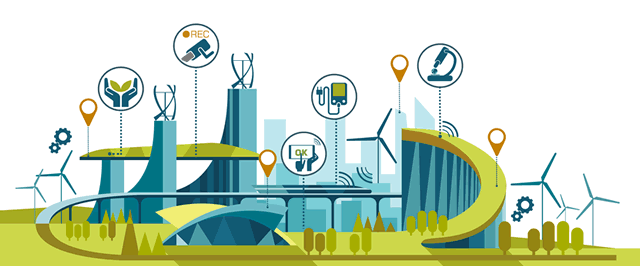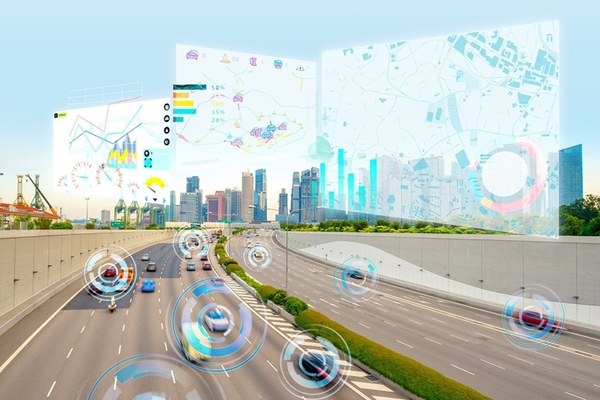In the bustling heart of the 21st century, urbanization has reached an unprecedented level, with cities becoming increasingly complex and interconnected. As urban populations continue to swell, the need for efficient, sustainable, and resilient cities has become more crucial than ever. This is where the concept of smart cities emerges, transforming urban living through the power of technology.
The Essence of Smart Cities

At its core, a smart city is an urban ecosystem that utilizes technology to optimize its infrastructure, services, and resources. It is a city that is not only intelligent but also responsive, adaptable, and citizen-centric. By leveraging advancements in technology, such as the Internet of Things (IoT), big data, artificial intelligence (AI), and cloud computing, smart cities aim to enhance the quality of life for their residents while minimizing environmental impact and promoting sustainable growth.
What is a Smart City?
A smart city is an urban ecosystem that utilizes technology to optimize its infrastructure, services, and resources. It is a city that is not only intelligent but also responsive, adaptable, and citizen-centric. By leveraging advancements in technology, such as the Internet of Things (IoT), big data, artificial intelligence (AI), and cloud computing, smart cities aim to enhance the quality of life for their residents while minimizing environmental impact and promoting sustainable growth.
The Pillars of a Smart City
The four pillars of smart cities are:
- Technology: The technological backbone of smart cities is the pervasive network of interconnected devices, sensors, and data analytics platforms. This network, often referred to as the IoT, collects real-time data from various aspects of city life, including traffic patterns, energy consumption, environmental conditions, and public safety concerns. This vast pool of data is then analyzed using advanced algorithms, enabling city officials to gain valuable insights into the city’s operations and make informed decisions to optimize resource allocation, improve service delivery, and enhance citizen engagement.
- Sustainability: Smart cities are committed to minimizing environmental impact and promoting sustainable practices. This includes initiatives such as energy efficiency measures, renewable energy integration, waste reduction, and green infrastructure development.
- Citizen Engagement: Smart cities empower citizens to participate in decision-making processes, report issues, and access city services more conveniently. This is achieved through digital platforms, mobile apps, open data initiatives, and community engagement programs.
- Economic Development: Smart cities foster a vibrant and innovative economic environment by supporting entrepreneurship, attracting talent, and investing in infrastructure that supports businesses.
Benefits of Smart Cities
Smart cities offer a multitude of benefits to their residents, including:
- Improved quality of life: Smart cities enhance the quality of life for their residents by providing access to better infrastructure, services, and amenities.
- Increased sustainability: Smart cities promote sustainability by reducing energy consumption, minimizing waste, and improving air and water quality.
- Enhanced economic opportunities: Smart cities foster economic growth by creating new jobs, attracting businesses, and supporting innovation.
- Empowered citizens: Smart cities empower citizens to participate in decision-making processes and improve their communities.
Challenges of Implementing Smart Cities
Despite the numerous benefits, there are also challenges to implementing smart cities, including:
- Cost: Implementing smart city technologies can be expensive, requiring significant upfront investments.
- Data security and privacy: Smart cities collect and store vast amounts of data, raising concerns about data security and privacy.
- Digital divide: Ensuring that all citizens have access to technology and digital literacy skills is crucial for the success of smart cities.
- Collaboration and governance: Smart cities require collaboration among various stakeholders, including governments, businesses, academia, and citizens, to ensure effective planning and implementation.
The Future of Smart Cities
The future of smart cities is bright, with advancements in technology opening up new possibilities for innovation and improvement. As technology continues to evolve, we can expect to see even more intelligent and responsive cities that enhance the quality of life for their residents and contribute to a more sustainable future.
Technology: The Driving Force of Smart Transformation

The technological backbone of smart cities is the pervasive network of interconnected devices, sensors, and data analytics platforms. This network, often referred to as the IoT, collects real-time data from various aspects of city life, including traffic patterns, energy consumption, environmental conditions, and public safety concerns. This vast pool of data is then analyzed using advanced algorithms, enabling city officials to gain valuable insights into the city’s operations and make informed decisions to optimize resource allocation, improve service delivery, and enhance citizen engagement.
The Dawn of Smart Cities
As urban populations continue to swell, cities face an array of challenges, including traffic congestion, resource scarcity, and environmental concerns. These challenges have spurred the emergence of smart cities, urban centers that harness the power of technology to optimize their infrastructure, services, and resources.
Technology: The Backbone of Smart Cities
At the heart of smart cities lies a network of interconnected devices, sensors, and data analytics platforms. This network, often referred to as the Internet of Things (IoT), collects real-time data from various aspects of city life, including traffic patterns, energy consumption, environmental conditions, and public safety concerns.
This vast pool of data, when analyzed using advanced algorithms, provides city officials with valuable insights into the city’s operations. These insights empower them to make informed decisions that optimize resource allocation, improve service delivery, and enhance citizen engagement.
Revolutionizing Urban Life
The impact of smart city technologies is already being felt in various aspects of urban life. Here are a few examples:
- Smart Transportation: Intelligent traffic management systems, real-time traffic updates, and smart parking solutions are easing congestion, reducing travel times, and improving air quality.
- Smart Energy: Smart grids and renewable energy integration are optimizing energy consumption, reducing reliance on fossil fuels, and promoting environmental sustainability.
- Smart Waste Management: Sensor-equipped bins and optimized collection routes are minimizing waste overflows, reducing transportation emissions, and promoting recycling and resource recovery.
- Smart Public Safety: Surveillance systems, data-driven crime prediction analytics, and emergency response coordination are enhancing public safety and improving response times.
- Smart Citizen Engagement: Digital platforms, mobile apps, and open data initiatives are empowering citizens to participate in decision-making processes, report issues, and access city services more conveniently.
The Future: Embracing Innovation and Collaboration
The future of smart cities is brimming with possibilities as technology continues to evolve at an exponential pace. Advancements in AI, machine learning, and data science will enable cities to become even more responsive, predictive, and personalized.
Creating truly smart cities, however, requires collaboration among various stakeholders, including governments, businesses, academia, and citizens. By working together, we can ensure that smart cities are inclusive, sustainable, and designed to benefit all members of society.
Real-world Applications: Revolutionizing Urban Life
The impact of smart city technologies is already being felt in various aspects of urban life. Here are a few examples:
- Smart Transportation: Intelligent traffic management systems, real-time traffic updates, and smart parking solutions are easing congestion, reducing travel times, and improving air quality.
- Smart Energy: Smart grids and renewable energy integration are optimizing energy consumption, reducing reliance on fossil fuels, and promoting environmental sustainability.
- Smart Waste Management: Sensor-equipped bins and optimized collection routes are minimizing waste overflows, reducing transportation emissions, and promoting recycling and resource recovery.
- Smart Public Safety: Surveillance systems, data-driven crime prediction analytics, and emergency response coordination are enhancing public safety and improving response times.
- Smart Citizen Engagement: Digital platforms, mobile apps, and open data initiatives are empowering citizens to participate in decision-making processes, report issues, and access city services more conveniently.
The Future of Smart Cities: Embracing Innovation and Collaboration

As technology continues to evolve at an exponential pace, the potential of smart cities is limitless. The future holds advancements in AI, machine learning, and data science that will enable cities to become even more responsive, predictive, and personalized. However, realizing the full potential of smart cities requires collaboration among various stakeholders, including governments, businesses, academia, and citizens. By working together, we can ensure that smart cities are inclusive, sustainable, and designed to benefit all members of society.
The Evolution of Smart Cities
Smart cities have evolved from mere concepts to tangible realities, transforming urban landscapes across the globe. The technological backbone of smart cities is the Internet of Things (IoT), a network of interconnected devices, sensors, and data analytics platforms. This network collects real-time data from various aspects of city life, providing valuable insights into traffic patterns, energy consumption, environmental conditions, and public safety concerns.
Technology: The Driving Force of Innovation
Technological advancements are continuously shaping the future of smart cities. Artificial intelligence (AI), machine learning (ML), and data science are playing increasingly prominent roles in optimizing resource allocation, improving service delivery, and enhancing citizen engagement. AI-powered traffic management systems can predict congestion and adjust traffic lights accordingly, while ML algorithms can analyze energy consumption patterns to optimize energy distribution.
Collaboration for Inclusive and Sustainable Smart Cities
Realizing the full potential of smart cities requires collaboration among various stakeholders, including governments, businesses, academia, and citizens. Governments can set the framework for smart city development, providing regulatory support and fostering innovation. Businesses can contribute by developing and deploying smart city technologies, while academia can provide research and expertise. Citizens, as the ultimate beneficiaries of smart cities, can actively participate in decision-making processes and provide valuable feedback.
Key Trends Shaping the Future of Smart Cities
- Personalized Urban Experiences: Smart city technologies will enable personalized urban experiences, tailoring services and infrastructure to individual needs. AI-powered systems can provide citizens with real-time information on traffic routes, public transportation options, and nearby amenities.
- Predictive Maintenance and Resource Management: Predictive analytics will empower cities to anticipate and prevent infrastructure failures, optimize resource consumption, and reduce environmental impact. AI algorithms can analyze sensor data from buildings, roads, and utilities to identify potential issues and schedule proactive maintenance.
- Data-Driven Governance and Citizen Engagement: Smart cities will leverage data to make informed decisions and enhance citizen engagement. Open data initiatives will provide citizens with access to real-time information, allowing them to participate in decision-making processes and report issues effectively.
- Cybersecurity and Data Privacy: Ensuring cybersecurity and data privacy will be paramount in smart cities, where vast amounts of sensitive data are collected and processed. Robust cybersecurity measures and data governance frameworks are essential to protect citizen privacy and prevent cyberattacks.
- Sustainable Development and Environmental Resilience: Smart cities will prioritize sustainable development and environmental resilience, incorporating renewable energy, reducing waste, and mitigating the impact of climate change. Smart grids will optimize energy usage, while sensor networks will monitor environmental conditions and inform proactive measures.
Conclusion: Smart Cities – A Paradigm Shift in Urban Living
Smart cities represent a paradigm shift in urban living, embracing technology to create a more efficient, sustainable, and citizen-centric future. By harnessing the power of innovation and collaboration, we can transform our cities into thriving ecosystems that enhance the quality of life for generations to come.
